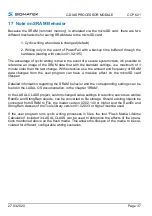
C-DIAS PROCESSOR MODULE
CCP 621
27.03.2020
Page 37
17 Note on SRAM Behavior
Because the SRAM (remnant memory) is emulated via the microSD card, there are two
different mechanisms for saving SRAM data to the microSD card:
1. Cyclic writing when data is changed (default)
2. Writing only in the event of PowerFail with a backup time buffered through the
hardware (starting with version 01.02.195)
The advantage of cyclic writing is that in the event of a severe system crash, it's possible to
reference an image of the SRAM data that with the standard settings, is a maximum of 1
minute older than the last change. With extensive use, the amount and frequency of SRAM
data changes from the user program can have a massive effect on the microSD card
lifespan.
Detailed information regarding the SRAM behavior and the corresponding settings can be
found in the LASAL OS documentation, in the chapter “SRAM”.
In the LASAL CLASS project, seldom changed value settings in retentive servers as well as
RamEx and StringRam objects, can be converted to file storage. Should existing objects be
converted from SRAM to File, the loader version 02.02.140 or higher and the RamEx and
StringRam classes of the Tools library version 01.02.033 or higher must be used.
If the user program run
s cyclic writing processes in files, the tool “Flash Media Lifetime
Calculation” included in LASAL CLASS can be used to determine the effects of the opera-
tions mentioned above on the flash media. This allows the lifespan of the media to be cal-
culated for different, configurable writing scenarios.
Summary of Contents for CCP 621
Page 10: ...CCP 621 C DIAS PROSESSOR MODULE Page 8 27 03 2020 2 Mechanical Dimensions...
Page 12: ...CCP 621 C DIAS PROSESSOR MODULE Page 10 27 03 2020 4 Connector Layout...
Page 21: ...C DIAS PROCESSOR MODULE CCP 621 27 03 2020 Page 19 9 Configuration of the Process Module...
Page 28: ...CCP 621 C DIAS PROSESSOR MODULE Page 26 27 03 2020 13 Process Diagram...








































